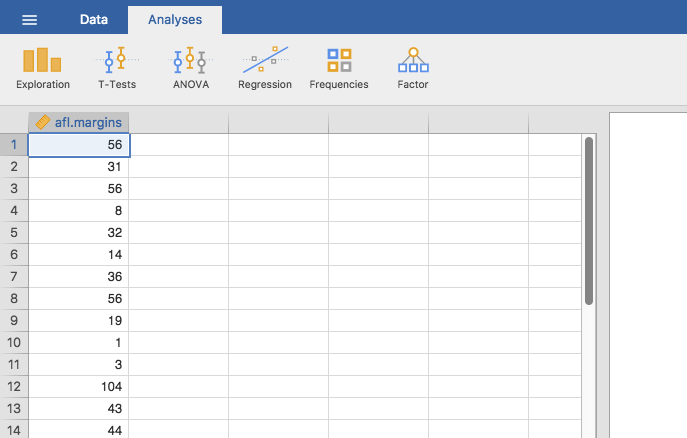Section author: Danielle J. Navarro and David R. Foxcroft
Descriptive statistics¶
Any time that you get a new data set to look at one of the first tasks
that you have to do is find ways of summarising the data in a compact,
easily understood fashion. This is what descriptive statistics (as
opposed to inferential statistics) is all about. In fact, to many people
the term “statistics” is synonymous with descriptive statistics. It is
this topic that we’ll consider in this chapter, but before going into
any details, let’s take a moment to get a sense of why we need
descriptive statistics. To do this, let’s open the aflsmall_margins
data set and see what variables are stored in the file
(Fig. 19).

Fig. 19 Screenshot of jamovi showing the variables in the aflsmall_margins
data set
In fact, there is just one variable here, afl.margins. We’ll focus a bit on
this variable in this chapter, so I’d better tell you what it is. Unlike most
of the data sets in this book, this is actually real data, relating to the
Australian Football League (AFL).[1] The afl.margins variable contains
the winning margin (number of points) for all 176 home and away games played
during the 2010 season.
This output doesn’t make it easy to get a sense of what the data are actually
saying. Just “looking at the data” isn’t a terribly effective way of
understanding data. In order to get some idea about what the data are actually
saying we need to calculate some descriptive statistics (this chapter) and draw
some nice pictures (chapter Drawing graphs).
Since the descriptive statistics are the easier of the two topics I’ll start
with those, but nevertheless I’ll show you a histogram of the afl.margins
variable since it should help you get a sense of what the data we’re trying to
describe actually look like, see Fig. 20. We’ll talk a lot
more about how to draw histograms. For now,
it’s enough to look at the histogram and note that it provides a fairly
interpretable representation of the afl.margins variable.
Fig. 20 Histogram of the AFL 2010 winning margin data (the afl.margins
variable). As you might expect, the larger the winning margin the less
frequently you tend to see it.
| [1] | Note for non-Australians: the AFL is an Australian rules football competition. You don’t need to know anything about Australian rules in order to follow this section. |